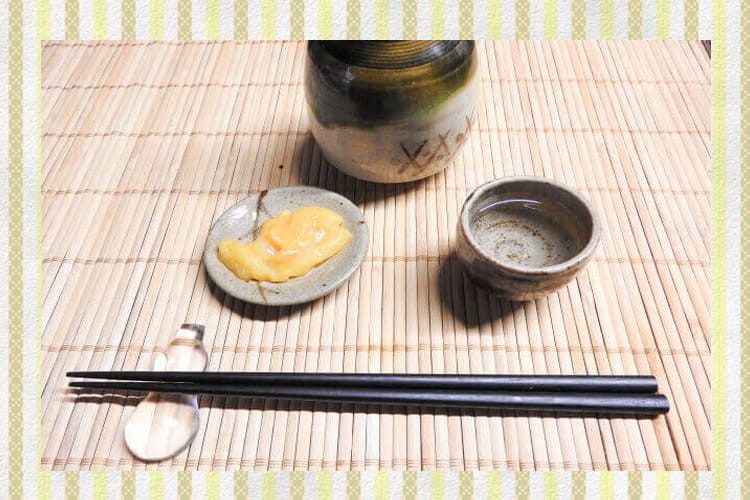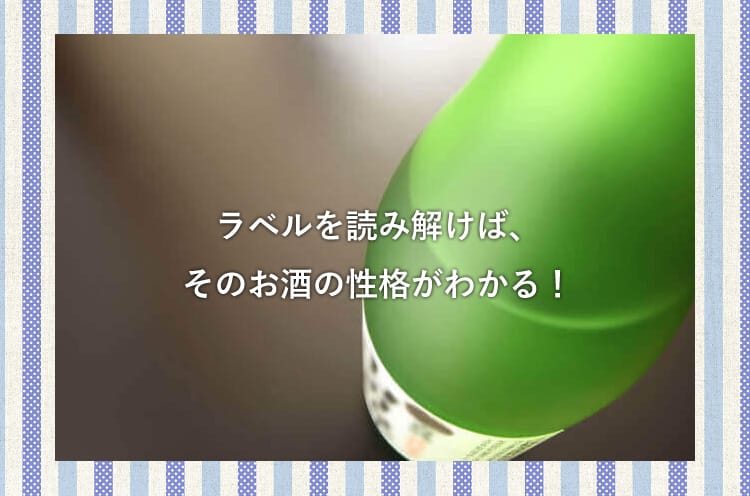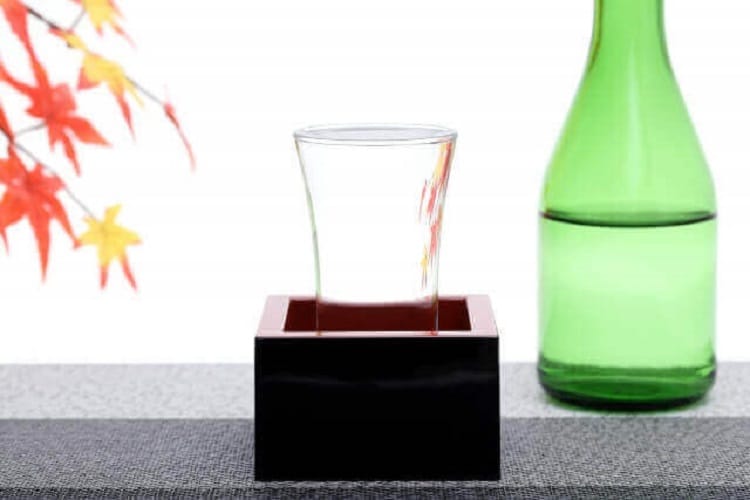
Although I went to a liquor store to say, “I want to drink delicious sake!”, There are many people who have experienced that they don't know what to choose for so many kinds. Isn't it?
A reliable helper who can help you when you get lost is stuck in the bottle"label".Like other wines and other liquors, sake labels are a treasure trove of information.. At the same time, it is a message from the brewery.
If you understand exactly what is on the label, you will no longer be afraid to choose alcohol at a liquor store. Let's learn here so that you can choose what tastes like "I want to drink now!"
If you read the label, you can understand the nature of the sake!

Japanese sake has labels on the front and back of the bottle. In many cases, there are three types of labels. I will explain each one.
~ Table label ~
First is the table label.A label affixed to the front side of the bottle bodyis. In most cases, this is the minimum information required:
・ Specific name liquor
Specified name liquor depends on the raw materials such as whether or not to add brewed alcohol, the ratio of rice polishing, the production method, etc. It is divided into total 8 types of rice, special and brewed sake. This description tells you which sake is classified into which specific name.
・ Brand
The name of the brand of liquor. Even if you don't know the name of the brewery, you probably know the brand. Brands that are reputed to be delicious or that you have heard of their names are also important options.
・ Item
It is written as “Sake” or “Sake”.
・ Sake brewery name
The name of the brewery that made the sake is clearly stated.
~ Shoulder label ~
A label affixed diagonally on a gentle part above the body of the bottle.is. It is also called “shoulder”.
This shoulder labelThe sales point of the liquor that you want to appeal especially to consumers, such as contest awards, special manufacturing methods, brewing year, etc.Is described.
-Back label-
It is a label affixed to the back of the bottle body.Unlike table labels, here is detailed data on ingredients. In other words, it's like a “resume” of alcohol.
Numerical data is only a guide. However, it is very important information because knowing the history and profile of the liquor makes it possible to investigate certain taste trends.
Some liquor stores allow you to taste tastings, so you can check the actual taste, but if you can't taste it, the information on this back label will serve as a reliable navigator.
・ Raw material name
Rice, rice bran, etc.Indicates the name of the raw material used. If the rice varieties such as “Yamada Nishiki”, “500 Mangoku” and “Miyama Nishiki” are listed, you can choose the rice you like.
“Omachi”, with many core fans, seems to have a lot of people who choose rice.
・ Rice milling rate
Polishing rice,The ratio of the remaining part (= actually used for preparation) as a percentage.
Generally, if you cut a lot of rice, it tends to be light. On the contrary, if you don't cut too much, it will tend to have a dark taste, and it will be finished in a type that will allow you to taste plenty of rice.
So, you can imagine the taste here too.
·Alcohol degree
Represents the amount of alcohol contained in the liquor. Alcohol content of sake is roughly15-16% averageis. By the way, it is approximately 18% if it is original sake before we add water.
·yeast
It is a notation about the yeast used.Yeast is one of the factors that greatly affect the aroma and taste of sake..
“It seems that you can enjoy a gorgeous scent because it uses Kyoto 9”, or “Shizuoka Yeast will be finished in a fruity and beautiful taste” etc. so that you can choose with yeast If it becomes, it can be said that it has already reached the maniac realm.
・ Sake degree
A numerical value representing the specific gravity of sake.Standard is 0.+ (Plus) means less sugar, conversely minus (-) means more sugar.
In other words, there is a tendency to become dry as + (plus) and as sweet as minus (-).
However, even if the sake level is the same, the impression of sweetness or spicy changes greatly depending on the degree of acidity described below. Therefore, it can be considered as an approximate guideline for judgment.
·acidity
Represents the amount of organic acids (malic acid, citric acid, lactic acid, succinic acid, etc.) contained in sake.If the acidity is high, it feels hot, and if it is low, it feels light and sweet.There is a trend.
This acidity is also closely related to the degree of sake.If the sake level is high and the acidity is high, it is rich and dry. If the sake level is high and the acidity is low, it is easy to feel light and dry.It is said that.
・ Amino acid content
The amount of amino acids contained in sake.Approximate shade of taste.
In general,The more amino acids there are, the deeper the taste and richness, and vice versa..
·capacity
The amount of sake in the container.
·Manufacturing date
It is the year and month packed in the container.
By the way, there are many things that have been labeled "BY" these days.
BY stands for Brewery Year, meaning "brewing year"is. The world of sake is a bit different,7 year from 1 month 6 day to 30 month 1 day of next yearIt is stipulated.
For example, if you write "29BY", it means that it was created from the 29 month 7 day of Heisei 1 to the 30 month 6 day of Heisei 30. This system was established in Showa 40, and this sake brewing year is used not only for sake but also for authentic shochu, mirin and fruit sake.
One of the most enjoyable ways to find a year's liquor that will be a milestone or memorial, such as marriage, childbirth, new home construction or entrepreneurshipis. I think it will be even more pleasing if you give it along with the reason why you chose BY not only when you buy it for yourself but also when you give it to someone.
By the way, some of the more advanced players are saying “It's a hobby to drink and compare BY differences of the same brand”. You can enjoy various ways with just one BY.
・ Name of manufacturer
This is the name and address of the brewery that made the sake.
Recommended temperature range
"Cool it" "At room temperature", etc.It is often written what temperature is recommended to drink the liquor.
・ Cooking dishes
Some of them are written about examples of delicious dishes when taken with the sake. It's very helpful when you know what food you want to eat.
By the way,Recently, there is an increasing number of sakes that do not include ingredient data.. The reason seems to be "I want you to drink it and feel it with your own senses without being influenced by the data".
Certainly, if you get too clever, you can't deny the possibility that your senses and sensibility will be dragged by preconceptions. I want to enjoy both knowledge and sensitivity.
Information to put on the label, information that is not good to put

Details on the sake label are determined by the law called the Liquor Industry Association Act. There are three rules.
"Necessary items" that must be displayed, "Optional items" that can be displayed if the requirements are met, and "Prohibited items" that cannot be displayed.
Although it is a little technical and detailed, please read it if you are interested.
1) Required information
① Raw material name
The raw materials usedListed in descending order of usage(Excluding water). For sake that displays a specific name,It is necessary to display the milling rate at a location close to the display location of the raw material name..
② Production time
The date when a product container such as a bottle is packedis. For example, if the sake is packed in 2018 (Heisei 30 year) 12 month, write it in one of the following ways.
Date of manufacture 30 of Heisei 12 / Date of manufacture 30.12 / Date of manufacture 2018.12 / Date of manufacture 18.12
In addition, if the capacity of the container is less than 300ml, the characters “Year / Month” may be omitted. Because the label itself is small.
By the way,There is no expiration date because sake can maintain its quality for several years if it is stored correctly in a cool and dark place..
③ Precautions for storage or drinking
In the case of sake that is shipped without any heat treatment, such as fresh sake, the precautions for storage or drinking are described.
By the way,In general, refrigerated storage at 5 ° C or lower is recommended for fresh sakeIt is done.
④ Country of origin
In case of imported products, description is required.
⑤ Display of products using foreign sake
For sake produced in Japan using both domestic and foreign sake, the country of origin and percentage of use of the foreign sake are listed..
Regarding the usage rate,It may be described with a width of 10%It is supposed to be.
In addition to the above, it is mandatory for sake producers to include the following items.
・ Manufacturing location (may be displayed as a symbol)
・ Capacity of container
・ Sake (may be displayed as `` Sake '')
・ Alcohol content (may be described with a width of 1%)
・ Those with foaming properties
・ Languages such as “Liquor is 20 years old” and “Minor drinking is prohibited by law”
2) Optional information
The following items can be displayed when applicable to each requirement.
① Variety name of raw rice
When the usage rate of raw rice to be displayed exceeds 50%, it can be displayed together with the usage rate, for example, "Yamada Nishiki 100%".
② Name of sake
Can be displayed if everything is brewed in the place of production. Therefore,It is not allowed to display the name of the locality for sake that is blended with different origins.
③ Storage years
For sake that has been stored for more than 1 years, you can display the number of years rounded down to the nearest 1..
By the way, when blending different storage years,Display the shortest storage yearsWill be required.
④ Raw sake
It can be displayed for sake that has not been adjusted by adding water after preparation..
In addition, it is safe to adjust the water content within the range of less than 1% alcohol.
⑤ Fresh sake
After production,When heat treatment is not performed at allCan be displayed.
⑥ Raw storage
After production,When storing without heat treatment and heat treatment at the time of shipmentCan be displayed.
⑦ Raw one
Pure rice sake made only in a single factoryThe display is permitted.
⑧ Barrel
Sake with a wooden incense and stored in a wooden barrelCan be displayed.
It doesn't matter if it is in a wooden container at the time of sale.
用語 Terms that give the impression of superior quality, such as “excellent”, “excellent”, “luxury”
When there are multiple sakes of the same type or brand in your company, you can display the one with the best quality. Display by comparison with products of other companies is not allowed.
In addition, labeling is permitted only when it can be explained objectively from the raw materials used.
受 賞 Award description
If the award is received from a public organization such as a national or local government, it can be displayed.
Items other than the above may be displayed only if they are separately explained based on the facts.In addition, display of brand name and specific name liquor is optional.
In addition, the component value (sake degree, acidity, amino acid degree, etc.), Mr. Tsuji's school, the yeast used, the hardness of the feed water, the koji ratio (the ratio of sake lees left after purification. The higher the koji ratio, the more You will have less liquor.
In other words, That's why it's a luxurious sakeI understand that. The number of days of moromi (the time taken from the attachment to the upper tank) may be indicated.
3) Display prohibited items
The following items must not be marked on containers or packaging.
② Government purveyor or similar terms
③ Terminology similar to the specific name for sake other than the specific name
However, close to the display of terms similar to a specific name,In principle, if there is an explanation that clearly shows that the size of the letter is 8 points or more and that it does not fall under the specific name sake, there is no problem even if it is displayed..
